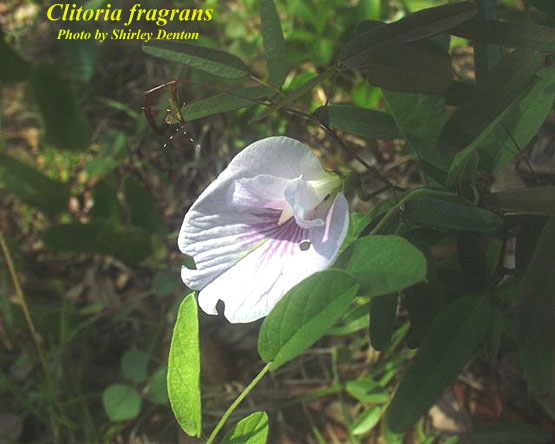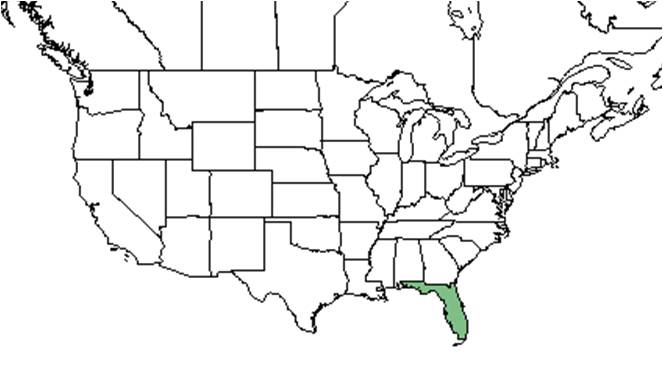Clitoria fragrans
| Clitoria fragrans | |
|---|---|

| |
| Photo by Shirley Denton (Copyrighted, use by photographer’s permission only), Atlas of Florida Vascular Plants | |
| Scientific classification | |
| Kingdom: | Plantae |
| Division: | Magnoliophyta - Flowering plants |
| Class: | Magnoliopsida - Dicotyledons |
| Order: | Fabales |
| Family: | Fabaceae ⁄ Leguminosae |
| Genus: | Clitoria |
| Species: | C. fragrans |
| Binomial name | |
| Clitoria fragrans Small | |

| |
| Natural range of Clitoria fragrans from USDA NRCS Plants Database. | |
Common name: Sweetscented pigeonwings
Contents
Taxonomic notes
Synonym: Martiusia fragrans (Small) Small The Plant List.org
The common name, pigeon wings, is due to the flowers' bird-like appearance.[1]
Description
C. fragrans is a perennial, erect, suffrutescent herb that is found in scrub and sandhill habitats along the Lake Wales Ridge,[2][3] It is distinguishable from other legumes by its non-twining habit, prominent stipules, three foliate leaves, and resupinate flowers.[4][3] It has both chasmogamous and cleistogamous fowers.[1]
Distribution
C. fragrans is endemic to the Lake Wales Ridge and is an endangered species in Florida,[5] and its distribution is limited by the rapidly disappearing scrub habitat due to agriculture and residential development.[1]
Ecology
Habitat
C. fragrans can be found in the xeric soils of turkey oak scrubs and sandhills along the Lake Wales Ridge[2][6](Menges et al. 2007). It often can be found occupying open, sandy spaces between shrubs, along sandy fire lanes, and between citrus groves.[6][7]
Associated species include Quercus, Gordonia, Vitis, Pinus, Aristida stricta, Quercus laevis and Quercus incana.[5][6]
Phenology
C. fragrans has both chasmogamous and cleistogamous flowers[1] and has been observed to produce more cleistogamous flowers and fruit than chamogamous structures.[3] The chasmogamous flowers are lavender, with darker purplish lines and white throats[8] and can be observed blooming May to June.[1][6][9] Cleistogamous flowers occur later in the summer through late September.[1]
Seed dispersal
It exhibits ballistic seed dispersal, this results in most of the new individuals coming from plants already established in the population.[3] The cleistogamous and chasmogamous seeds have been observed to not have morphological differences.[3] Fruits are three sided achenes.[7]
Fire ecology
C. fragrans is found in pyrogenic habitats along the Lake Wales Ridge and has a long taproot to increase fire survival.[10] Fire increases both flowering and population density in plants; however, it has been observed flowering in a site not burned for thirty years[1][3] Plants in long-unburned sites have been observed to rarely produce cleistogamous flowers.[7] Weekley and Menges (2003) observed a moderate resprouting response to fire.[11]
Pollination
Clitoria fragrans has been observed at the Archbold Biological Station to host leafcutting bees such as Megachile petulans (family Megachilidae).[12]
Herbivory and toxicology
C. fragrans is a host plant to the long-tailed skipper.[8]
Conservation, cultivation, and restoration
C. fragrans is a federally threatened and endangered species in Florida. A major threat to the species is the conversion of habitat on the Lake Wales Ridge to agriculture and urbanization; this also leads to population fragmentation.[7].
In order to prevent further population loss, prescribed fire is suggested.[5]
Cultural use
Photo Gallery
References and notes
- ↑ 1.0 1.1 1.2 1.3 1.4 1.5 1.6 [FWS] Accessed: December 7, 2015
- ↑ 2.0 2.1 Small, John K.. “A New Butterfly-pea from Florida.”. Torreya 26.3 (1926): 56–57.
- ↑ 3.0 3.1 3.2 3.3 3.4 3.5 Lewis, M.N. 2000. Life History and Reproductive Biology of Clitoria fragrans Relative to Fire History on the Avon Park Air Force Range. University of Central Florida.
- ↑ Frantz, P.R. 1977. A Monograph of the genus Clitoria (Leguminosae Glycineae) [Ph.D. dissertation]. Univ. Florida. pp. 696-705
- ↑ 5.0 5.1 5.2 [FNAI] Accessed: December 7, 2015
- ↑ 6.0 6.1 6.2 6.3 Florida State University Robert K. Godfrey Herbarium database. URL: http://herbarium.bio.fsu.edu. Last accessed: October 2015. Collectors: R.K. Godfrey, O. Lakela, Grady W. Reinert, John K. Small, Edgar T. Wherry. States and Counties: Florida: Highlands, Polk. Compiled by Tall Timbers Research Station and Land Conservancy.
- ↑ 7.0 7.1 7.2 7.3 Palazzo, A.J., Hardy, S.E., Cary, T.J., and Bashore, T. 2007 A Review of the Growth Habits and Restoration Issues for Clitoria fragrans and Polygonella basiramia. US Army Corps of Engineers Engineer Research and Development Center.
- ↑ 8.0 8.1 [Native Florida Wildflowers]Accessed: December 7, 2015
- ↑ Nelson, G. PanFlora: Plant data for the eastern United States with emphasis on the Southeastern Coastal Plains, Florida, and the Florida Panhandle. www.gilnelson.com/PanFlora/ Accessed: 19 MAY 2021
- ↑ [NatureServe] Accessed: December 7, 2015
- ↑ Weekley, C.S. and E.S. Menges. 2003a. Species and vegetation responses to prescribed fire in a longunburned, endemic-rich Lake Wales Ridge scrub. Journal of the Torrey Botanical Society 130(4):265-282.
- ↑ Deyrup, M.A. and N.D. 2015. Database of observations of Hymenoptera visitations to flowers of plants on Archbold Biological Station, Florida, USA.